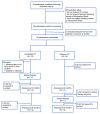Imaginator: A Proof-of-Concept Feasibility Trial of a Brief Imagery-Based Psychological Intervention for Young People Who Self-Harm
- PMID: 32057131
- PMCID: PMC7613067
- DOI: 10.1111/sltb.12620
Imaginator: A Proof-of-Concept Feasibility Trial of a Brief Imagery-Based Psychological Intervention for Young People Who Self-Harm
Abstract
Objectives: The Imaginator study tested the feasibility of a short mental imagery-based psychological intervention for young people who self-harm and used a stepped-wedge design to investigate effects on self-harm frequency reduction at 3 and 6 months.
Method: A total of 38 participants aged 16-25 were recruited via community self-referral and mental health services. Participants were randomized to immediate delivery of Functional Imagery Training (FIT) or usual care followed by delayed delivery after 3 months. FIT comprised two face-to-face sessions, five phone sessions, and use of a smartphone app. Outcomes' assessment was blind to allocation.
Results: Three quarters of those who began treatment completed face-to-face sessions, and 57% completed five or more sessions in total. Self-harm frequency data were obtained on 76% of the sample at 3 months (primary outcome) and 63% at 6 months. FIT produced moderate reductions in self-harm frequency at 3 months after immediate (d = 0.65) and delayed delivery (d = 0.75). The Immediate FIT group maintained improvements from 3 to 6 months (d = 0.05). Participants receiving usual care also reduced self-harm (d = 0.47).
Conclusions: A brief mental imagery-based psychological intervention targeting self-harm in young people is feasible and may comprise a novel transdiagnostic treatment for self-harm.
© 2020 The American Association of Suicidology.
Conflict of interest statement
Martina Di Simplicio and Emily A. Holmes are co-authors of a book on imagery-based cognitive therapy (Guildford press, 2019)
References
-
- American Psychiatric Association. Diagnostic and statistical manual of mental disorders 5. American Psychiatric Association; Washington DC: 2013.
-
- Aveyard B, Appiah-Kusi E, Barnicot K, Wilkinson P, Kavanagh DJ, Holmes EA, Di Simplicio M. Young people’s experiences of an imagery-based intervention targeting self-harm, supported by a digital app. (in preparation)
Publication types
MeSH terms
Grants and funding
LinkOut - more resources
Full Text Sources
Medical



